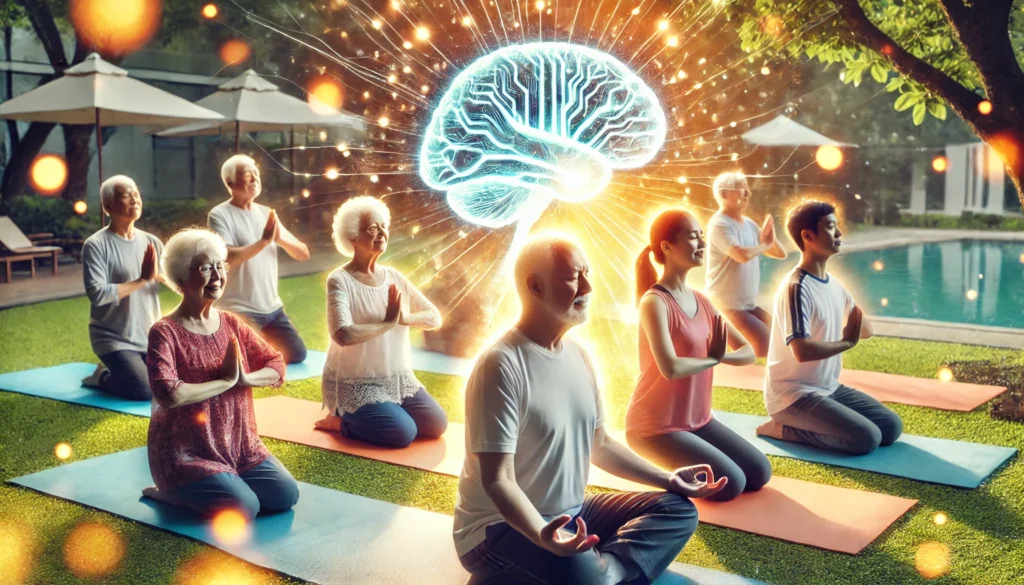In recent years, exercise has gained significant attention as a potential intervention for dementia, a condition that affects millions worldwide. But can exercise reverse dementia, or at the very least, prevent its onset? Let’s delve into the scientific evidence, explore current trends, and consider future implications of exercise in managing and potentially mitigating dementia.
You may also like: Top Herbs to Enhance Your Focus
Understanding Dementia and Its Impact
Dementia is not a single disease but an umbrella term that encompasses various cognitive impairments, including Alzheimer’s disease, the most common form. It is characterized by memory loss, language difficulties, and impaired problem-solving abilities, which can severely affect daily life.
The Rising Challenge
With the aging global population, dementia is becoming increasingly prevalent. According to the World Health Organization (WHO), approximately 55 million people globally live with dementia, and this number is expected to rise to 78 million by 2030. This growing prevalence underscores the urgent need for effective interventions.
Global Demographic Shifts
The shift in global demographics, particularly the increase in the aging population, poses significant challenges for healthcare systems worldwide. As life expectancy rises, more individuals are reaching an age where dementia becomes a higher risk, creating a pressing need for sustainable healthcare solutions.
Economic Impact
The economic burden of dementia is profound, affecting not just healthcare systems but also families and caregivers. The costs associated with dementia care, including medical expenses and caregiving, are substantial and are projected to increase as the prevalence of dementia rises.
Social and Emotional Effects
Beyond financial strain, dementia also imposes social and emotional challenges on patients and their families. The progressive nature of the disease often leads to isolation and changes in family dynamics, highlighting the need for comprehensive support systems.
Historical Context of Dementia Treatment
Historically, treatment options for dementia have been limited, focusing primarily on managing symptoms rather than reversing or preventing the condition. Pharmaceutical interventions have shown limited efficacy, leading researchers to explore alternative approaches, including lifestyle modifications such as exercise.
Early Treatment Approaches
In the early stages of dementia research, treatment efforts primarily centered around managing symptoms through medications aimed at neurotransmitter regulation. These approaches, while somewhat effective in symptom relief, did not address the root causes of cognitive decline.
The Shift Towards Holistic Care
As understanding of dementia has evolved, there has been a shift towards more holistic care strategies. Integrating lifestyle factors, such as diet, social engagement, and exercise, into treatment plans is becoming increasingly recognized for its potential in enhancing patient outcomes.
The Role of Non-Pharmacological Interventions
Non-pharmacological interventions, including cognitive therapies and physical activities, are gaining recognition for their ability to complement traditional treatments. These interventions focus on enhancing quality of life and potentially slowing disease progression.
The Role of Exercise in Dementia Prevention
The concept of using exercise as a preventive measure for dementia is gaining traction. Numerous studies have examined the potential benefits of physical activity in reducing the risk of cognitive decline.
The Biological Mechanisms
Exercise is believed to influence dementia risk through several biological mechanisms. Physical activity increases blood flow to the brain, promoting the growth of new neurons and enhancing synaptic plasticity. Additionally, exercise helps reduce inflammation and oxidative stress, both of which are implicated in neurodegenerative diseases.
Neurogenesis and Synaptic Plasticity
Physical activity stimulates neurogenesis, the process of generating new neurons, particularly in the hippocampus, a brain region crucial for memory and learning. Enhanced synaptic plasticity, the ability of synapses to strengthen or weaken over time, is vital for cognitive function and is positively influenced by regular exercise.
Reduction of Inflammation
Chronic inflammation is a known risk factor for many neurodegenerative diseases, including dementia. Exercise helps modulate the immune system, reducing systemic inflammation and potentially lowering the risk of cognitive decline.
Oxidative Stress Management
Oxidative stress, an imbalance between free radicals and antioxidants in the body, contributes to neuronal damage. Regular physical activity enhances the body’s antioxidant defenses, mitigating oxidative stress and protecting brain cells.

Evidence from Research
A study published in the Journal of Alzheimer’s Disease found that regular physical activity can reduce the risk of developing Alzheimer’s by up to 50%. Another study in the Archives of Neurology indicated that even moderate exercise levels can slow the progression of cognitive decline in individuals with mild cognitive impairment.
Longitudinal Studies
Long-term studies have consistently demonstrated a correlation between physical activity and reduced dementia risk. These studies underscore the importance of maintaining an active lifestyle throughout life to preserve cognitive health in older age.
Meta-Analyses and Systematic Reviews
Comprehensive reviews and meta-analyses of numerous studies provide robust evidence supporting the role of exercise in reducing dementia risk. These analyses highlight the consistency of findings across different populations and types of physical activity.
Gender and Age Considerations
Research also suggests that the benefits of exercise on cognitive health may vary based on gender and age. Understanding these nuances can help tailor exercise recommendations to maximize protective effects against dementia.
Exercise as an Intervention for Existing Dementia
While preventing dementia is critical, addressing the needs of those already living with the condition is equally important. Can exercise serve as a viable intervention for those with dementia?
Improving Cognitive Function
Research suggests that exercise can improve cognitive function in individuals with dementia. A study in the Journal of Aging and Physical Activity found that regular physical activity can enhance memory, attention, and executive function in dementia patients.
Mechanisms of Cognitive Improvement
Engaging in physical activity boosts brain-derived neurotrophic factor (BDNF), which supports neuronal health and cognitive function. Exercise-induced improvements in cerebral blood flow and neuroplasticity also contribute to cognitive enhancements.
Types of Cognitive Gains
Different forms of exercise can target various cognitive domains. For example, aerobic activities may primarily enhance memory, while resistance training can improve executive functions, providing a comprehensive cognitive benefit profile.
Individual Variability
Cognitive improvements from exercise can vary among individuals, influenced by factors such as the stage of dementia, baseline cognitive function, and adherence to exercise regimens. Personalized exercise plans can optimize cognitive outcomes.
Enhancing Quality of Life
Beyond cognitive benefits, exercise can also improve the overall quality of life for individuals with dementia. Physical activity has been associated with better mood, reduced anxiety, and improved physical health, all of which contribute to a higher quality of life.
Psychological Benefits
Exercise can alleviate symptoms of depression and anxiety, common in dementia patients, by releasing endorphins and promoting a sense of well-being. These psychological benefits enhance overall life satisfaction and emotional resilience.
Social Engagement
Participating in group exercise activities provides opportunities for social interaction, reducing feelings of isolation and fostering a sense of community. Social engagement is crucial for mental health and can be a motivating factor for continued participation in exercise programs.
Physical Health Improvements
Regular exercise contributes to better physical health by maintaining mobility, reducing fall risk, and managing comorbid conditions such as hypertension and diabetes. Improved physical health can lead to greater independence and a better quality of life.
Designing an Exercise Program for Dementia
For health and wellness coaches, science journalists, and biohackers interested in the intersection of exercise and dementia, understanding how to design an effective exercise program is crucial.
Tailoring the Approach
When designing an exercise program for individuals with dementia, it is essential to tailor the approach to the individual’s abilities and preferences. Activities should be enjoyable and feasible, taking into account any physical limitations or comorbidities.
Assessing Individual Needs
A comprehensive assessment of the individual’s physical and cognitive capabilities is critical in designing an effective exercise program. Understanding their interests and limitations ensures that the program is both safe and engaging.
Incorporating Variety
Introducing a variety of exercises can prevent boredom and enhance overall physical benefits. Combining aerobic, strength, and flexibility exercises caters to different aspects of physical health and keeps individuals motivated.
Monitoring Progress
Regular monitoring and adjustment of the exercise program are necessary to accommodate changes in the individual’s condition. Feedback from participants can guide modifications to enhance efficacy and adherence.
Types of Exercise
- Aerobic Exercise: Activities such as walking, swimming, or cycling can enhance cardiovascular health and improve cognitive function.
- Strength Training: Building muscle strength can improve balance, reduce fall risk, and enhance overall physical health.
- Flexibility and Balance: Yoga or tai chi can improve flexibility and balance, reducing fall risk and promoting relaxation.
Aerobic Exercise Benefits
Aerobic exercises improve cardiovascular health, which is closely linked to brain health. These activities increase heart rate, improving blood circulation to the brain and supporting cognitive function.
Strength Training Importance
Strength training not only builds muscle mass but also enhances coordination and balance. These improvements reduce the risk of falls, a common concern for individuals with dementia, thereby promoting safety and confidence.

Flexibility and Balance Activities
Practices like yoga and tai chi focus on slow, deliberate movements and breath control, which enhance flexibility and balance. These activities also provide relaxation and stress reduction benefits, supporting mental well-being.
Frequency and Intensity
The frequency and intensity of exercise should be individualized. Generally, engaging in moderate-intensity exercise for at least 150 minutes per week is recommended. However, even shorter, more frequent sessions can be beneficial, especially for those with limited stamina.
Recommended Guidelines
Adhering to established guidelines, such as the World Health Organization’s recommendations, provides a framework for exercise frequency and intensity. Tailoring these guidelines to individual needs ensures safety and effectiveness.
Balancing Intensity and Recovery
Finding the right balance between exercise intensity and recovery is crucial for individuals with dementia. Overexertion can lead to fatigue and decreased motivation, while adequate recovery promotes consistent participation.
Adapting to Changes
As dementia progresses, adapting exercise intensity and duration is necessary to align with changing capabilities. Flexibility in program design ensures continued engagement and benefits.
The Future of Exercise and Dementia Research
As research into the relationship between exercise and dementia continues, several promising avenues are emerging.
Technological Advancements
Wearable fitness technology and virtual reality are being explored as tools to enhance the accessibility and effectiveness of exercise interventions for dementia patients. These technologies can provide personalized feedback and motivation, making exercise more engaging and effective.
Wearable Devices
Devices like fitness trackers monitor physical activity levels, providing real-time feedback and encouraging adherence to exercise programs. Data from wearables can also inform healthcare providers about patient progress and areas needing adjustment.
Virtual Reality Applications
Virtual reality offers immersive exercise experiences that can be particularly beneficial for individuals with limited mobility. These applications simulate various environments, making exercise enjoyable and tailored to individual preferences.
Telehealth Integration
Telehealth platforms facilitate remote monitoring and guidance for exercise programs, increasing accessibility for individuals unable to attend in-person sessions. This integration supports continuity of care and personalized intervention.
Integration with Other Interventions
Future research may focus on integrating exercise with other interventions, such as cognitive training or dietary modifications, to enhance outcomes for individuals with dementia.
Synergistic Effects
Combining exercise with cognitive training may produce synergistic effects, enhancing both physical and cognitive health. This integrated approach can maximize the benefits of each intervention, potentially slowing dementia progression.
Nutritional Considerations
Dietary modifications, alongside exercise, can provide comprehensive support for brain health. Nutrients that reduce inflammation and support neuronal function complement the cognitive benefits of physical activity.
Holistic Health Models
Developing holistic health models that incorporate exercise, diet, cognitive training, and social engagement offers a comprehensive strategy for managing dementia. These models emphasize the interconnectedness of various health domains.
Conclusion: A Promising Path Forward
While exercise alone may not reverse dementia, it holds significant promise as a preventive measure and intervention for cognitive decline. By promoting brain health, improving cognitive function, and enhancing quality of life, exercise can be a valuable component of a comprehensive dementia management strategy.
For health and wellness coaches, science journalists, and biohackers, understanding the potential of exercise in the context of dementia can inform the advice and insights you provide to your clients, readers, and communities. As research progresses, staying informed about new developments in this field will be essential to leveraging exercise as a powerful tool in the fight against dementia.
Ongoing Research and Developments
Continued research is crucial to understanding the full potential of exercise in dementia care. Staying updated on the latest findings enables stakeholders to implement evidence-based practices in their work.
Advocacy and Awareness
Raising awareness about the benefits of exercise for dementia prevention and management is vital. Advocacy efforts can help shift public perceptions and encourage policy changes to support accessible exercise programs for at-risk populations.

Empowering Communities
Empowering communities with knowledge and resources to promote physical activity can lead to widespread benefits. Community-based programs and initiatives can foster environments where exercise is an integral part of daily life, supporting brain health and overall well-being.
Further Reading:
The impact of exercise on patients with dementia
Important Note: The information contained in this article is for general informational purposes only, and should not be construed as health or medical advice, nor is it intended to diagnose, prevent, treat, or cure any disease or health condition. Before embarking on any diet, fitness regimen, or program of nutritional supplementation, it is advisable to consult your healthcare professional in order to determine its safety and probable efficacy in terms of your individual state of health.
Regarding Nutritional Supplements Or Other Non-Prescription Health Products: If any nutritional supplements or other non-prescription health products are mentioned in the foregoing article, any claims or statements made about them have not been evaluated by the U.S. Food and Drug Administration, and such nutritional supplements or other health products are not intended to diagnose, treat, cure, or prevent any disease.


